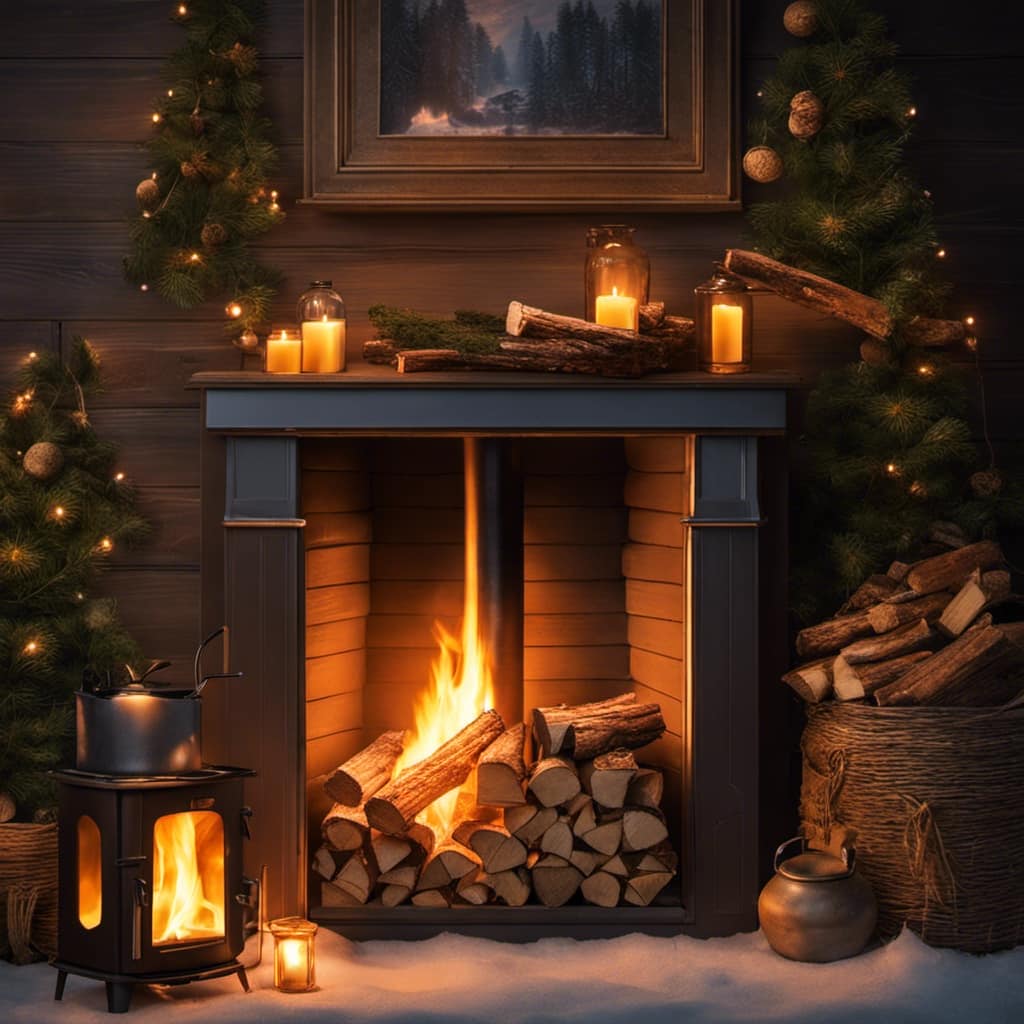As an enthusiast of wood stoves, the charming dance of flames and the warm, inviting heat they distribute across a room have always fascinated me.
But have you ever wondered how this ingenious contraption actually works? Well, let me break it down for you.
A wood stove operates on the principle of combustion, where wood is burned to produce heat. With careful control of airflow and proper fuel selection, this efficient heating system ensures a cozy and safe environment.
So, let’s dive into the fascinating world of wood stove mechanics!

Key Takeaways
- The combustion process in a wood stove requires proper firebox preparation and is affected by factors such as wood type, moisture content, and airflow.
- Heat production and transfer in a wood stove involve the use of insulation materials, refractory bricks, heat exchangers, and various heat distribution methods to maximize heat transfer.
- Airflow control and regulation in a wood stove play a crucial role in efficient combustion and heat distribution, with primary and secondary air supplies and dampers being key components.
- Fuel selection and preparation, including using hardwoods for higher energy content, proper seasoning of firewood, and reducing moisture content, are important for efficient burning in a wood stove.
The Combustion Process
I love the smell of a wood-burning fire and watching its mesmerizing flames during the combustion process.
The ignition process of a wood stove is crucial in achieving efficient and effective heating. It begins with the preparation of the firebox, ensuring adequate airflow for the combustion to occur. Once the fire is lit, the wood undergoes a series of chemical reactions, releasing heat and gases.
The efficiency of the wood stove is measured by how well it converts the wood’s energy into heat. Factors like the type of wood, moisture content, and proper airflow affect the combustion efficiency.
To optimize efficiency, it’s essential to maintain the firebox, ensure proper air intake, and select well-seasoned wood. Regular cleaning and inspection are also necessary to prevent creosote buildup and maintain optimal performance.

Heat Production and Transfer
The wood stove efficiently transfers heat throughout the room, providing a cozy and comfortable ambiance. This is achieved through a combination of insulation materials and heat distribution methods.
The stove is typically constructed with materials such as refractory bricks, which have excellent insulation properties to prevent heat loss. These bricks are placed around the combustion chamber to keep the heat contained within the stove.
Additionally, the stove is designed with a series of channels and vents that help distribute the heat evenly. Airflow is carefully controlled to ensure efficient combustion and heat transfer.
The stove’s design also incorporates a heat exchanger, which further enhances heat distribution by transferring the heat from the stove’s combustion gases to the surrounding air.

Overall, the wood stove’s insulation materials and heat distribution methods work together to maximize heat transfer and create a warm and inviting atmosphere.
Airflow Control and Regulation
Proper airflow control and regulation within a wood stove is crucial for efficient combustion and heat distribution. The management of airflow in a wood stove directly affects the temperature regulation and overall performance of the stove. Here are three key aspects of airflow management and temperature regulation in a wood stove:
Primary Air Intake: The primary air intake controls the amount of oxygen supplied to the fire. A larger opening allows for a more intense fire, while a smaller opening reduces the fire’s intensity. Adjusting the primary air intake helps regulate the temperature within the stove.
Secondary Air Supply: The secondary air supply plays a vital role in complete combustion. It introduces additional oxygen to the stove, ensuring that all the wood gases are burned efficiently. This helps maximize heat output and minimize harmful emissions.

Damper Control: The damper is responsible for controlling the airflow through the chimney. By adjusting the damper, the user can regulate the draft and control the burn rate. This allows for a consistent and steady supply of heat.
Proper airflow management and temperature regulation are essential for achieving optimal combustion and heat distribution in a wood stove. Once the airflow is controlled, the next step is to carefully select and prepare the right fuel for efficient burning.
Fuel Selection and Preparation
Choosing and preparing the right fuel for efficient burning is crucial in achieving optimal combustion and heat distribution in a wood stove. When it comes to fuel selection, it’s important to consider the type of wood and its moisture content.
Hardwoods like oak and maple are excellent choices as they’ve a higher energy content and burn longer. Softwoods like pine and fir, on the other hand, burn faster and are better for starting the fire.

It’s also essential to properly season the firewood by cutting and storing it in a well-ventilated area for at least six months. This allows the wood to dry, reducing its moisture content and ensuring a cleaner burn. Properly dried firewood not only produces more heat but also reduces the risk of creosote buildup in the chimney.
Maintenance and Safety Tips
I always make sure to regularly clean out the ash from my wood stove to prevent any buildup that could potentially cause a fire hazard. Proper cleaning techniques are essential for maintaining the efficiency and safety of your wood stove.
Here are three important aspects to consider when it comes to cleaning and troubleshooting common issues with wood stoves:
Ash Removal: Regularly remove the ash from the firebox using a metal shovel or vacuum designed for wood stoves. Dispose of the ash in a metal container, as it can retain heat for extended periods.

Glass Cleaning: Over time, the glass door of your wood stove can become dirty and affect the view of the fire. Use a specialized glass cleaner or a mixture of vinegar and water to remove soot and grime.
Chimney Maintenance: Ensure your chimney is free of creosote buildup by scheduling regular professional inspections and cleanings. Creosote can ignite and cause chimney fires, so it’s crucial to keep it under control.
What is the basic operation of a wood stove and how can I use a Rutland wood stove effectively?
The basic operation of a wood stove involves loading it with firewood, igniting the wood, and adjusting the airflow to keep the fire burning. To use a Rutland wood stove effectively, follow the manufacturer’s instructions for installation, use seasoned wood, and regularly clean the stove and chimney. How to use a Rutland wood stove will depend on its individual features and specifications.
Frequently Asked Questions
What Are the Different Types of Wood Stoves Available in the Market?
There are various types of wood stoves available in the market, each with its own benefits. They provide efficient and cost-effective heating solutions, making them a popular choice for many homeowners.
Can a Wood Stove Be Used as the Primary Source of Heating for a Whole House?
Yes, a wood stove can be used as the primary source of heating for a whole house. Wood stoves are efficient and offer benefits such as cost savings, backup heating during power outages, and the cozy ambiance of a fire.

How Long Does It Take for a Wood Stove to Heat up a Room?
It usually takes about 30 minutes for my wood stove to heat up a room. Factors like wood stove efficiency, insulation, and room size can affect the heating time. But once it’s roaring, it warms the place up like a charm.
Is It Safe to Leave a Wood Stove Unattended Overnight?
No, it is not safe to leave a wood stove unattended overnight. Precautions for using a wood stove overnight include ensuring proper ventilation, clearing away flammable materials, and regularly checking for any signs of malfunction.
Can a Wood Stove Be Used for Cooking?
Yes, a wood stove can be used for cooking. While it may seem unconventional, using a wood stove for cooking has its benefits. Wood stove cooking techniques can add unique flavors and the stove’s heat distribution is ideal for cooking.
Conclusion
In conclusion, a wood stove is like a fiery artist, transforming logs into a cozy embrace of warmth. Through the combustion process, it releases heat that’s transferred into our homes, creating a comforting atmosphere.

With careful airflow control and fuel selection, we can dance with the flames, ensuring efficient and safe operation. Don’t forget regular maintenance and safety precautions to keep this enchanting performer shining bright in our lives.
So gather ’round, let the wood stove enchant you with its mesmerizing dance of fire.
Growing up surrounded by the vast beauty of nature, Sierra was always drawn to the call of the wild. While others sought the comfort of the familiar, she ventured out, embracing the unpredictable and finding stories in the heartbeat of nature.
At the epicenter of every remarkable venture lies a dynamic team—a fusion of diverse talents, visions, and passions. The essence of Best Small Wood Stoves is crafted and refined by such a trio: Sierra, Logan, and Terra. Their collective expertise has transformed the platform into a leading authority on small wood stoves, radiating warmth and knowledge in equal measure.











